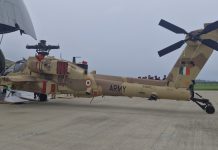Imagine the dead of night over the rugged borders of South Asia, where the roar of jet engines once echoed Pakistan’s false bravado.
On May 7, 2025, that arrogance met its match. In a blaze of precision-guided fury, Indian forces unleashed Operation Sindoor—a masterful symphony of missiles and drones that didn’t just hit targets; it dismantled the very backbone of Pakistan’s aerial might.
This wasn’t a reckless skirmish; it was a calculated reckoning, downing five Pakistani fighter jets and a critical surveillance aircraft in the largest surface-to-air kill ever recorded.
And yet, amid the craters and wreckage, naysayers at home and peace-peddling diplomats abroad dare to question: Was it worth it? Did it achieve anything?
To them, I say: Wake up. Operation Sindoor wasn’t just a victory; it was a statement. India struck, Pakistan crumbled, and the world watched as we redefined deterrence. If you’re still doubting, let’s dive into the facts that shut down the skeptics and expose the hollow calls for “peace” that ignore the blood on terrorist hands.
In the wake of the devastating Pahalgam terror attack that claimed innocent lives and exposed Pakistan’s enduring sponsorship of jihadist proxies, India had no choice but to respond.
Operation Sindoor, named after the vermilion mark symbolizing unyielding resolve in Indian culture, targeted nine terrorist infrastructure sites across Pakistan and Pakistan-occupied Kashmir.
But it went further, crippling the Pakistani Air Force (PAF) at its core. Satellite imagery and intelligence reports confirm widespread damage to air bases, radar systems, and command centers—dealing a blow that has left Pakistan’s military scrambling for repairs and excuses.
As Air Chief Marshal Amar Preet Singh revealed just hours ago, this operation marked the end of the “Balakot ghost,” where past strikes were clouded by denial.
Here, the evidence is irrefutable: F-16 hangars reduced to rubble, runways pockmarked with craters, and aircraft vaporized mid-flight.
This is the story of how India turned grief into glory, and why the critics—whether opposition politicians whining about “narrative failure” or international mediators pushing premature ceasefires—need to sit down and learn.

The Genesis: From Terror To Thunder
To understand Operation Sindoor, we must rewind to the catalyst: the Pahalgam attack in early May 2025, orchestrated by Pakistan-based militants like Jaish-e-Mohammed.
Twenty-six civilians perished in a cowardly assault that echoed the horrors of Pulwama and Uri. Pakistan’s Inter-Services Intelligence (ISI) fingerprints were all over it, as declassified reports later confirmed.
Prime Minister Narendra Modi’s government, true to its doctrine of proactive defense, authorized a response that evolved from the 2019 Balakot strikes. But Sindoor was bolder, deeper, and more devastating—penetrating up to 300 kilometers into enemy territory with BrahMos cruise missiles, Scalp munitions, and Akash surface-to-air systems, all combat-proven in this theater.
Naysayers (some major figures) labeled it a ‘failure’. They argued that the operation escalated tensions without resolution.
But let’s dismantle that myth right here.
Sindoor wasn’t about occupation or regime change; it was surgical deterrence. By striking air bases that harbored or supported terrorist logistics, India neutralized immediate threats and sent a message: Sponsor terror and your skies will burn.
Peace negotiators, from Pakistan’s PM Shehbaz Sharif pleading for talks “for the sake of peace” to China’s calls for “restraint,” conveniently forget that true peace requires accountability, not appeasement.
Sharif’s overtures came only after his air force was humbled—proof that strength, not dialogue alone, forces the hand of aggressors.
Striking The Heart: Shahbaz (Jacobabad) Air Base
Let’s break it down base by base, starting with Shahbaz in Jacobabad, the crown jewel of Pakistan’s F-16 fleet.
This base, a hub for frontline fighter operations, was hit with pinpoint accuracy. Intelligence confirmed partial destruction of a major hangar—“one half gone”—likely incinerating jets inside, including possible AEW&C assets. Satellite analysts noted smoke plumes and structural collapse, corroborated by independent observers.
Suggested messaging? “At Shahbaz (Jacobabad), India struck the very hub of Pakistan’s frontline fighter deployability—reducing hangar capability and crippling aircraft readiness.
Their core air defense posture was directly hit.” This isn’t hyperbole; it’s fact. Critics who claim “no critical assets lost” are parroting Pakistani propaganda, which the IAF chief debunked with evidence of downed F-16s.
To the so-called peace-negotiating Nobel prize aspirant. How can you negotiate with a nation that denies its own losses while harboring terrorists? Operation Sindoor exposed that hypocrisy, forcing Pakistan to ground its fleet for repairs and rethink its adventurism.
Expanding on the strategic ripple: Shahbaz’s degradation disrupted PAF’s western flank operations, limiting their ability to support ground forces in Kashmir or launch cross-border incursions.
Historical parallels?
Think of the 1971 Indo-Pak War, where Indian strikes on East Pakistan airfields paved the way for liberation. Sindoor echoes that legacy but with modern precision—zero civilian casualties on India’s side, per reports.
Naysayers calling it a “many failures” operation, ignore this: Without Sindoor, another Pahalgam was inevitable. Peace? Only after justice.
The Nerve Center: Nur Khan (Rawalpindi) Air Base
Moving to Nur Khan in Rawalpindi, near Islamabad’s power corridors. This base, a logistical lifeline, faced cruise missile barrages that cratered runways, torched refueling hangars, and obliterated mobile control centers.
Pakistan’s denials rang hollow against satellite confirmation of infrastructure scars. The strikes eroded command mobility, leaving PAF scrambling during countermeasures.
Messaging: “Strikes at Nur Khan targeted runway access, refueling infrastructure, and mobile control nodes—eroding Pakistan’s ability to project air power from its most strategic hub near Islamabad.”

Relatable? Absolutely. This base isn’t just military; it’s symbolic of Pakistan’s elite shielding terrorists. A few critics in India, questioning why we stopped under “pressure,” miss the point: We achieved objectives without full-scale war.
As PM implied, Pakistan “begged for peace” via backchannels. Peace negotiators like the US, mediating the ceasefire, should thank India for restraint—not lecture on de-escalation while ignoring Islamabad’s terror factories.
Delving deeper, Nur Khan’s hits disrupted PAF’s C4ISR (Command, Control, Communications, Computers, Intelligence, Surveillance, Reconnaissance) network.
In military terms, this is game-changing: Without refueling, jets can’t sustain patrols; without controls, coordination falters. Analysts note this as a “strategic setback,” aligning with India’s evolving doctrine from reactive to proactive. To shut down naysayers claiming “narrative failure”: Videos and intel are public now—watch them before whining.
Deep Penetration: Mushaf (Sargodha) Air Base
Mushaf in Sargodha, once deemed “beyond reach,” felt India’s wrath with runway craters that halted operations. This base, key for deep-strike capabilities, saw its tarmac turned into Swiss cheese, per satellite intel. The IAF chief highlighted it as PAF’s “crown jewel,” now at mercy.
Statement: “At Mushaf in Sargodha, previously beyond our reach—we surgically disabled runway sections, directly interrupting Pakistan’s deep-penetration air capabilities.”
Critics arguing for escalation? Sargodha housed assets used in past aggressions; striking it prevented future ones. Peace calls from China, prioritizing “stability,” ring false—Beijing’s Belt and Road ties with Pakistan blind them to terrorism.
India’s response: We act for our security, not foreign agendas.
Strategically, Mushaf’s downtime forced PAF to redistribute assets, stretching resources thin. This mirrors Israel’s precision ops against Iranian proxies—effective, minimal collateral. Naysayers, dismissing it as “on point but flawed,” overlook the deterrence value: Pakistan’s nuclear brinkmanship failed.
The Wider Net: Strikes On Multiple Bases
India didn’t stop at majors; at least eight other bases—Rafiqui, Murid, Rahim Yar Khan, Sukkur, Chunian, Pasrur, and Sialkot—faced precision hell. Radar systems shattered, air defense nodes neutralized, command infrastructure in tatters.
Messaging: “Across the theatre, we struck Rafiqui, Murid, Rahim Yar Khan, Sukkur, Chunian, Pasrur, and Sialkot—neutralizing radar systems, air defense nodes, and command infrastructure—and dismantling their air network’s coverage.”
This widespread degradation disrupted PAF’s nationwide integrity, per experts. To naysayers calling it “on point” but criticizing execution: Look at X posts—independent observers confirm hits, despite Pakistani denials. Peace advocates? Their “restraint” pleas enabled past attacks; Sindoor broke that cycle.
Overall Impact: A Strategic Masterstroke
Satellite analytics paint a grim picture for Pakistan: Heavy damage to four major bases, 11 facilities hit in total, including air defenses. Net effect? Profound disruption to air projection and coordination.
Statement: “Satellite analytics reveal that several of Pakistan’s forward operating bases and air-defense systems suffered severe degradation—marking a strategic setback to their regional aerial posture.” This blow to PAF’s dominance echoes in strategic discussions, where even skeptics admit India’s edge.
Shutting Down The Naysayers
Now, to the doubters: People questioning “pressure” to stop? We stopped because objectives were met—not US tweets from Trump.
Critics calling it “failure”? A few articles ignore confirmed kills. Relatable truth: India won militarily; narratives falter when politics interfere.
Dismissing Peace Peddlers
Peace negotiators—Sharif, China, global leaders—call for talks post-strikes. But peace without dismantling terror is surrender. Sindoor proved: Dialogue follows strength. Kashmir deserves peace, but not at India’s expense.
Conclusion: India’s Unyielding Resolve
Operation Sindoor wasn’t mere tactics; it was the dismemberment of Pakistan’s aerial architecture. From Shahbaz hangars to Mushaf runways, every strike hit home. To naysayers: Facts trump fiction.
To peace-mongers: Strength secures talks. India rises, unbreakable.
- Group Captain MJ Augustine Vinod (Retd), VSM, is a former Mirage 2000 fighter pilot, air accident investigator, and co-founder of AMOS Aerospace. He writes on emerging defense technologies, AI in warfare, and India’s aviation future.
- This is an Opinion Article. Views Personal Of The Author
- He tweets at @mjavinod




